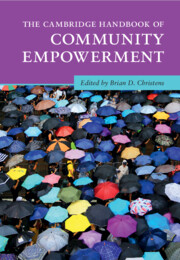Book contents
- The Cambridge Handbook of Community Empowerment
- Cambridge Handbooks in Psychology
- The Cambridge Handbook of Community Empowerment
- Copyright page
- Contents
- Figures
- Tables
- Contributors
- Building Community Power
- Part I Organizing and Activism
- Part II Participatory Governance
- Part III Civil Society and Coalitions
- Part IV Enterprise
- Part V Participatory and Community Arts
- Part VI Education and Engaged Research
- 20 Action Civics
- 21 Gender–Sexuality Alliances
- 22 Youth Participatory Action Research in School Settings
- 23 Community-Based Education
- 24 Community-Engaged Research
- Concluding Thoughts on Building Community Power
- Contributor Details
- Index
- References
Concluding Thoughts on Building Community Power
from Part VI - Education and Engaged Research
Published online by Cambridge University Press: 18 April 2024
- The Cambridge Handbook of Community Empowerment
- Cambridge Handbooks in Psychology
- The Cambridge Handbook of Community Empowerment
- Copyright page
- Contents
- Figures
- Tables
- Contributors
- Building Community Power
- Part I Organizing and Activism
- Part II Participatory Governance
- Part III Civil Society and Coalitions
- Part IV Enterprise
- Part V Participatory and Community Arts
- Part VI Education and Engaged Research
- 20 Action Civics
- 21 Gender–Sexuality Alliances
- 22 Youth Participatory Action Research in School Settings
- 23 Community-Based Education
- 24 Community-Engaged Research
- Concluding Thoughts on Building Community Power
- Contributor Details
- Index
- References
Summary
The chapters in this book have each examined different approaches to building community power through organizations and participatory processes. Some of these approaches represent long-standing and widespread forms of practice (e.g., community organizing, neighborhood associations, participatory urban planning) that are continuously evolving. Other approaches are more emergent or are currently spreading to more localities (e.g., action civics, participatory budgeting) and are exerting influences on existing organizations and forms of practice. Research into each of these approaches varies accordingly, with some approaches having a robust foundation of research-based insights and others that have only recently become the focus of empirical studies. The contributors to this book are at the forefront of advancing research on each of these types of community empowerment processes. Many of them are doing so from an action research orientation, in collaboration with the organizations, initiatives, and networks that are establishing and supporting these efforts.
- Type
- Chapter
- Information
- The Cambridge Handbook of Community Empowerment , pp. 632 - 651Publisher: Cambridge University PressPrint publication year: 2024

